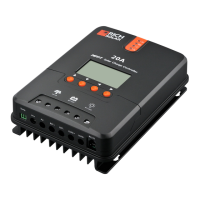-2.3 Exterior and Interfaces
2. PRODUCT INTRODUCTION
-2.4 Introduction to Maximum Power Point Tracking Technology
RS232
Fig. 1-1 Product appearance and interfaces
①
②
③
④
⑤
⑥
⑦
⑧
⑨
⑩
⑪
⑫
⑬
⑭
⑮
Battery "+" interface
Battery "-" interface
Load "+" interface
Load "-" interface
External temperature sampling interface
RS232 communication interface
Charging indicator
Battery indicator
Load indicator
Abnormality indicator
LCD screen
Operating keys
Installation hole
Solar panel "+" interface
Solar panel "-" interface
No. No.
Item
Item
①
② ③ ④ ⑤ ⑥
Definition
Transmitting terminal TX
Receiving terminal RX
Power supply grounding /Signal grounding
Power supply grounding /Signal grounding
Power supply positive
Power supply positive
No.
⑨ ⑩⑪ ⑫⑬
⑭
⑮
⑦
①
②
③
④
⑤
⑥
⑧
Maximum Power Point Tracking (MPPT) is an advanced charging technology that enables the solar panel to output more power by adjusting
the electric module's operating status. Due to the nonlinearity of solar arrays, there exists a maximum energy output point (maximum power
point) on their curves. Unable to continuously lock onto this point to charge the battery, conventional controllers (employing switching and
PWM charging technologies) can't get the most of the power from the solar panel. But a solar charge controller featuring MPPT technology
can continuously track arrays' maximum power point so as to get the maximum amount of power to charge the battery.
Take a 12V system as an example. As the solar panel's peak voltage (Vpp) is approximately 17V while the battery's voltage is around 12V,
when charging with a conventional charge controller, the solar panel's voltage will stay at around 12V, failing to deliver the maximum power.
However, the MPPT controller can overcome the problem by adjusting the solar panel's input voltage and current in real time, realizing a
maximum input power.
02
-2.1 Product Overview
This product can keep monitoring the solar panel's generating power and tracking the highest voltage and current values (VI) in real time,
enabling the system to charge the battery in maximum power. It's designed to be used in offgrid solar photovoltaic systems to coordinate
operation of the solar panel, battery and load, functioning as the core control unit in off-grid photovoltaic systems.
This product features an LCD screen which can dynamically display the operating status, operating parameters, controller logs, control
parameters, etc. Users can conveniently check parameters by the keys, and modify control parameters to cater to different system
requirements.
The controller utilizes standard Modbus communication protocol, making it easy for users to check and modify system parameters on their
own. Besides, by providing free monitoring software, we give users the maximum convenience to satisfy their varied needs for remote
monitoring.
With comprehensive electronic fault self-detecting functions and powerful electronic protection functions built inside the controller,
component damage caused by installation errors or system failures can be avoided to the greatest extent possible.
1/ SPECIFICATION
2/ PRODUCT INTRODUCTION
1. SPECIFICATION
-2.2 Product Features
With the advanced dual-peak or multi-peak tracking technology, when the solar panel is shadowed or part of the panel fails resulting in
multiple peaks on the I-V curve, the controller is still able to accurately track the maximum power point.
A built-in maximum power point tracking algorithm can significantly improve the energy utilization efficiency of photovoltaic systems, and
raise the charging efficiency by 15% to 20% compared with the conventional PWM method.
A combination of multiple tracking algorithms enables accurate tracking of the optimum working point on the I-V curve in an extremely short
time.
The product boasts an optimum MPPT tracking efficiency of up to 99.9%.
Advanced digital power supply technologies raise the circuit's energy conversion efficiency to as high as 98%.
Charging program options are available for different types of batteries including gel batteries, sealed batteries, open batteries, lithium
batteries, etc.
The controller features a limited current charging mode. When the solar panel power exceeds a certain level and the charging current is larger
than the rated current, the controller will automatically lower the charging power and bring the charging current to the rated level.
Instantaneous large current startup of capacitive loads is supported.
Automatic recognition of battery voltage is supported.
LED fault indicators and an LCD screen which can display abnormality information help users to quickly identify system faults.
Historical data storage function is available, and data can be stored for up to a year.
The controller is equipped with an LCD screen with which users can not only check device operating data and statuses, but also modify
controller parameters.
The controller supports standard Modbus protocol, fulfilling the communication needs of various occasions.
The controller employs a built-in over-temperature protection mechanism. When temperature surpasses the set value, the charging current
will decline in linear proportion to the temperature so as to curb the temperature rise of the controller, effectively keeping the controller from
being damaged by overheat.
Featuring a temperature compensation function, the controller can automatically adjust charging and discharging parameters in order to
extend the battery's service life.
TVS lighting protection.
RS-MPPT30
RS-MPPT20
RS-MPPT40
01

